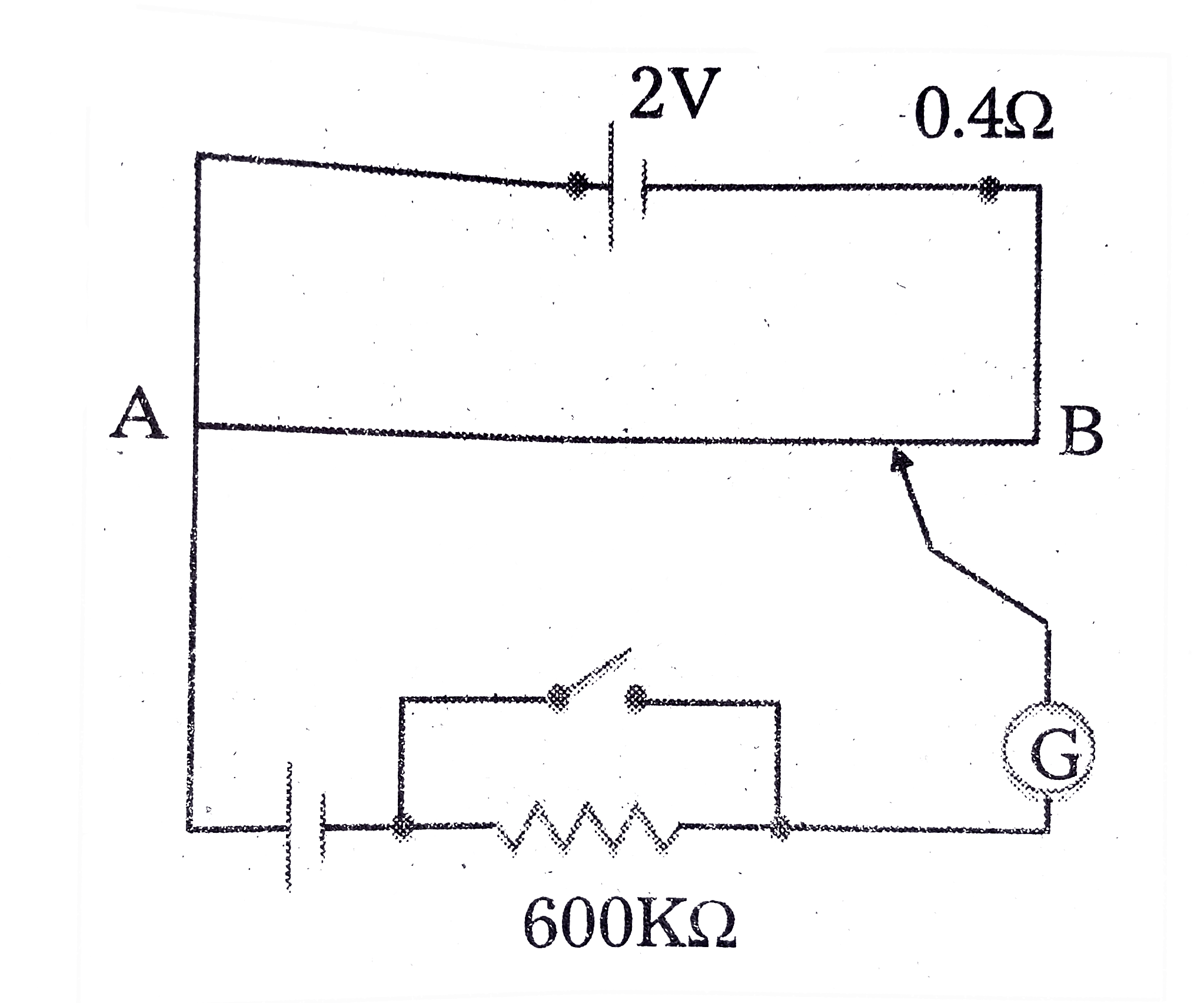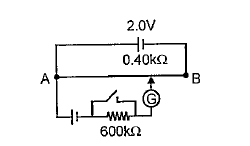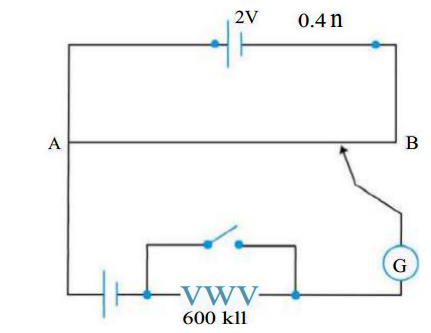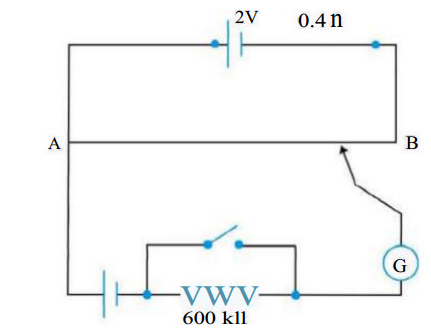Figure shows a potentiometer with a cell of 2.0 V and internal resistance 0.40Ω maintain a potential drop across the resistor wire AB. A standard cell which maintains a constant emf of 1.02 V (for very moderate currents upto a few mA) gives a balances point at 63.3 cm length of the wire. To ensure very low currents drawn from the standard cell, a very high resistance of 600Ω is put is series with it, which is shortedd close to the balance point. The standard cell is then replaced by a cell of unknown emf ε and the balance point found similarly, turns out to be at 82.3 cm length of the wire.

Would the circuit work well for determining an extermely small emf, say of the order of a few mV (such as the typcial emf a thermo-couple)? if not, how will you modify the circuit?Solution in Telugu
The circuit will not work for measuring extermely small emf because in that case the balance point will be just close to the end A. To modify the circuit we have to use a suitable high resistance in series potential difference 1 cm of wire will decrese. Hence extermely small emf can be measured.
Similar Questions
Figure shows a potentiometer with a cell of 2.0 V and internal resistance 0.40 Omega maintaining a potential drop across the resistor wire AB. A standard cell which maintains a constant emf of 1.02 V (for every moderate currents upto a few mA) gives a balance point at 67.3 cm length of the wire. To ensure very low currents drawn from the standard cell, a very high resistance of 600 Omega is put in series with it, which is shorted close to the balance point. The standard cell is then replaced by a cell of unknown emf epsi and the balance point found similarly, turns out to be at 82.3 cm length of the wire. What is the value epsi ?
View SolutionFigure shows a potentiometer with a cell of 2.0 V and internal resistance 0.40 Ω maintaining a potential drop across the resistor wire AB. A standard cell which maintains a constant emf of 1.02 V (for every moderate currents upto a few mA) gives a balance point at 67.3 cm length of the wire. To ensure very low currents drawn from the standard cell, a very high resistance of 600 Ω is put in series with it, which is shorted close to the balance point. The standard cell is then replaced by a cell of unknown emf ε and the balance point found similarly, turns out to be at 82.3 cm length of the wire.

What purpose does the high resistance of 600 K Ω have ?
View SolutionFigure shows a potentiometer with a cell of 2.0 V and internal resistance 0.40 Omega maintaining a potential drop across the resistor wire AB. A standard cell which maintains a constant emf of 1.02 V (for every moderate currents upto a few mA) gives a balance point at 67.3 cm length of the wire. To ensure very low currents drawn from the standard cell, a very high resistance of 600 Omega is put in series with it, which is shorted close to the balance point. The standard cell is then replaced by a cell of unknown emf epsi and the balance point found similarly, turns out to be at 82.3 cm length of the wire. Would the method work in the above situation if the driver cell of the potentiometer had an emf of 1.0 V instead of 2.0 V?
View SolutionFig. shows a potentiometer with a cell of 2.0V and internal resistance 0.40Omega maintaining a potential drop across the resistor wire AB. A standard cell which maintains a constant emf of 1.02V (for very moderate currents upto a few pA) gives a balance point at 67.3 cm length of the wire. Io ensure very low currents drawn from the standard cell, a very high resistance of 600kOmega is put in series with it which is shorted close to the balance point. The standard cell is then, replaced by a cell of unknown emf e and the balance point found similarly turns out to be at 82.3 cm length of the wire, What purpose does the high resistance of 600kOmega have?
View SolutionFig. shows a potentiometer with a cell of 2.0V and internal resistance 0.40Ω maintaining a potential drop across the resistor wire AB. A standard cell which maintains a constant emf of 1.02V (for very moderate currents upto a few pA) gives a balance point at 67.3 cm length of the wire. to ensure very low currents drawn from the standard cell, a very high resistance of 600kΩ is put in series with it which is shorted close to the balance point. The standard cell is then, replaced by a cell of unknown emf e and the balance point found similarly turns out to be at 82.3 cm length of the wire,
Is the balance point affected by this high resistance?

View SolutionFigure shows a potentiometer with a cell of 2.0 V and internal resistance 0.40Ωmaintaining a potential drop across the resistor wire AB. A standard cell which maintains a constant emf of 1.02 V (for very moderate currents upto a few mA) gives a balance point at 67.3 cm length of the wire. To ensure very low currents drawn from the standard cell, a very high resistance of 600kΩ is put in series with it, which is shorted close to the balance point. The standard cell is then replaced by a cell of unknown emfε and the balance point found similarly, turns out to be at 82.3 cm length of the wire. What is the value ε ? :

View SolutionFigure shows a potentiometer with a cell of 2.0 V and internal resistance 0.40Ω maintaining a potential drop across the resistor wire AB. A standard cell which maintains a constant emf of 1.02 V (for very moderate currents upto a few mA) gives a balance point at 67.3 cm length of the wire. To ensure very low currents drawn from the standard cell, a very high resistance of 600kΩ is put in series with it, which is shorted close to the balance point. The standard cell is then replaced by a cell of unknown emfε and the balance point found similarly, turns out to be at 82.3 cm length of the wire. What purpose does the high resistance of 600kΩ have? :

View SolutionFigure 3.33 shows a potentiometer with a cell of 2.0 V and internal resistance 0.40 Omega maintaining a potential drop across the resistor wire AB. A standard cell which maintains a constant emf of 1.02 V (for very moderate currents upto a few mA) gives a balance point at 67.3 cm length of the wire. To ensure very low currents drawn from the standard cell, a very high resistance of 600 k Omega is put in series with it, which is shorted close to the balance point. The standard cell is then replaced by a cell of unknown emf epsilon and the balance point found similarly, turns out to be at 82.3 cm length of the wire. Is the balance point affected by the internal resistance of the driver cell?:
View Solution

